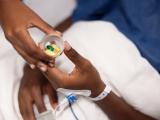October 22, 2009
Poll shows growing flu concern, uncertainty about vaccine
Americans are more concerned about pandemic H1N1 flu than they were a couple of months ago, with about 52% saying they are greatly or somewhat worried, according to the latest Washington Post–ABC poll. The number is up 13 percentage points from August. However, only about a third say they'll get the vaccine, though half said they'll have their kids vaccinated. Those saying they'll pass on the vaccine listed side-effect worries and perceived lack of testing as influencing their decision.
http://www.washingtonpost.com/wp-srv/politics/polls/postpoll_101909.html
Oct 15-18 Washington Post–ABC News Poll
Single dose of Chinese H1N1 vaccine found effective
In a clinical trial, a single 15-microgram dose of a nonadjuvanted H1N1 vaccine recently licensed in China was found to induce a probably protective immune response in volunteers between the ages of 12 and 60, according to an report published yesterday by the New England Journal of Medicine. Lesser immune responses were seen with a single dose in younger and older people. The vaccine is made by Hualan Biological Bacterin Co.
http://content.nejm.org/cgi/content/full/NEJMoa0908535
Oct 21 NEJM report
Canada's pandemic vaccine campaign will have an unadjuvanted option
Canada has purchased 1.8 million doses of unadjuvanted pandemic H1N1 vaccine to use in the youngest children as well as pregnant women and others who might want an alternative to the adjuvanted version, the Canadian Press reported yesterday. Canada's adjuvanted vaccine was approved on Oct 16. Officials predict that the unadjuvanted vaccine will be cleared in early November, but they don't want people to wait for it even though experts say it may produce a more robust response in children under age 3.
Doctors report rhabdomyolysis in pandemic flu patient
Australian physicians have documented a rare complication in a patient with pandemic H1N1 flu, myositis, and rhabdomyolysis. They reported their findings in an early online edition of the Pediatric Infectious Disease Journal. According to a news report today about the study, the 16-year-old boy experienced intense muscle pain and nearly black urine 3 days after his flu symptoms began in June when the first wave of the pandemic hit Australia. He recovered after 8 days in the hospital.
http://journals.lww.com/pidj/Abstract/publishahead/Melting_Muscles__Novel_H1N1_Influenza_A_Associated.99512.aspx
Oct 16 PIDJ abstract
Tamiflu treatment spawned resistance in Taiwan H1N1 case
Taiwan reported this week that the pandemic H1N1 virus became resistant to oseltamivir (Tamiflu) after a patient was treated with the drug. Oseltamivir-sensitive H1N1 was isolated from a 20-year-old man before treatment, the Taiwan Centers for Disease Control said. Three days later, after treatment began, an isolate from the man showed the resistance mutation. The man recovered, and there was no evidence that the virus spread to others. His case marked Taiwan's first report of H1N1 resistance to the agent.
http://www.cdc.gov.tw/ct.asp?xItem=26002&ctNode=960&mp=5
Oct 20 Taiwan CDC report
Flu control measures seem to reduce other diseases in Bolivia
Health officials in Bolivia say a massive campaign to promote handwashing to prevent H1N1 flu seems to have reduced the spread of other common diseases, according to a Time magazine report. Dr. Rene Lenis, Bolivia's director of epidemiology, reported a 10% to 15% drop in incidence of acute diarrheal diseases in all age-groups this year compared with last year. Public health agencies began promoting handwashing when the virus emerged in April.
http://www.time.com/time/health/article/0,8599,1931223,00.html?xid=rss-topstories
Oct 22 Time report
Egyptian capital cuts class sizes to curb flu spread
Egypt's health and education ministries have ordered schools in Cairo to halve class sizes to slow the spread of the pandemic virus, IRIN News, a United Nations publication, reported today. Children will attend school on 3 alternate days instead of 6 double-shift days, a variation on a long-standing system to reduce crowding. The World Health Organization has said school closures can be disruptive and has recommended that schools take other preventive measures, such as easing crowding.
http://www.irinnews.org/Report.aspx?ReportId=86695
Oct 22 IRIN story






















